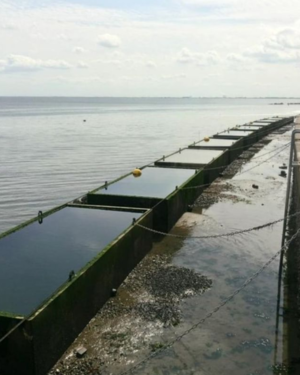PR 00174: verschil tussen versies
Geen bewerkingssamenvatting |
Geen bewerkingssamenvatting |
||
| (6 tussenliggende versies door dezelfde gebruiker niet weergegeven) | |||
| Regel 1: | Regel 1: | ||
[[Bestand:Onderwaterlab bakken.png|miniatuur|The underwater laboratory during low tide.]] | |||
Behind the research facility of NIOZ in Yerseke lie 12 concrete basins that are flooded during high tide and easy to reach during low tides. Within these basins experiments on how biodiversity can be enhanced on subtidal, hard structures like dikes or pillars of wind farms are performed. | Behind the research facility of NIOZ in Yerseke lie 12 concrete basins that are flooded during high tide and easy to reach during low tides. Within these basins experiments on how biodiversity can be enhanced on subtidal, hard structures like dikes or pillars of wind farms are performed. | ||
To meet current safety standards dikes need to be reinforced. In subtidal parts this is usually done through adding a layer of rock material or steel slag (a waste product of the steel industry with a high density). These reinforcements are often applied in soft sediment areas or on dikes with a high nature value. These locations often receive special protection due to their high natural value. The hard structures provide shelter for the European lobster and other important target species. Dike reinforcements can only take place when this natural value is preserved or compensated. | To meet current safety standards dikes need to be reinforced. In subtidal parts this is usually done through adding a layer of rock material or steel slag (a waste product of the steel industry with a high density). These reinforcements are often applied in soft sediment areas or on dikes with a high nature value. These locations often receive special protection due to their high natural value. The hard structures provide shelter for the European lobster and other important target species. Dike reinforcements can only take place when this natural value is preserved or compensated. | ||
The aim of Rijkswaterstaat is to protect the nature value of the subtidal parts of the dike through the addition of 'ecotops'. These ecotops exist of a ridge or pile of rocks which facilitate the reestablishment of the target species as well as a sheltered area that allows faster a sediment deposit. | The aim of Rijkswaterstaat is to protect the nature value of the subtidal parts of the dike through the addition of 'ecotops'. These ecotops exist of a ridge or pile of rocks which facilitate the reestablishment of the target species as well as a sheltered area that allows faster a sediment deposit. | ||
'''Research type:''' field research, desk analysis, lab research | '''Research type:''' field research, desk analysis, lab research | ||
'''Location:''' Easternscheldt, NIOZ Yerseke | '''Location:''' Easternscheldt, NIOZ Yerseke | ||
'''Contact:''' Tim van Ooijen | '''Contact:''' {{External link|resource=Resource Hyperlink 00706|name=Tim van Ooijen|dialog=process-linkwebsite-dialog}} | ||
{{Project config}} | {{Project config}} | ||
{{Project | {{Project | ||
| Regel 15: | Regel 17: | ||
|Start date=2019/09/23 | |Start date=2019/09/23 | ||
|End date=2024/12/31 | |End date=2024/12/31 | ||
|Summary=The underwater laboratory consists of 12 concrete basins in front of the NIOZ building in Yerseke. All of them are still in contact with the | |Summary=The underwater laboratory consists of 12 concrete basins in front of the NIOZ building in Yerseke. All of them are still in contact with the Easternscheldt during high tide. Within these basins research into how to enhance biodiversity on hard substrates like dykes and other man-made structures. | ||
Research type: field research, desk analysis, lab research | Research type: field research, desk analysis, lab research | ||
|Show summary=Nee | |Show summary=Nee | ||
|Contact person=CNTR 00020 | |Contact person=CNTR 00020 | ||
|Stakeholder=STKH 00064,STKH 00061 | |Stakeholder=STKH 00064,STKH 00061 | ||
|Show extra=Nee | |Show extra=Nee | ||
|Show navigation tree=Ja | |Show navigation tree=Ja | ||
Huidige versie van 24 mrt 2020 om 12:35
Behind the research facility of NIOZ in Yerseke lie 12 concrete basins that are flooded during high tide and easy to reach during low tides. Within these basins experiments on how biodiversity can be enhanced on subtidal, hard structures like dikes or pillars of wind farms are performed. To meet current safety standards dikes need to be reinforced. In subtidal parts this is usually done through adding a layer of rock material or steel slag (a waste product of the steel industry with a high density). These reinforcements are often applied in soft sediment areas or on dikes with a high nature value. These locations often receive special protection due to their high natural value. The hard structures provide shelter for the European lobster and other important target species. Dike reinforcements can only take place when this natural value is preserved or compensated.
The aim of Rijkswaterstaat is to protect the nature value of the subtidal parts of the dike through the addition of 'ecotops'. These ecotops exist of a ridge or pile of rocks which facilitate the reestablishment of the target species as well as a sheltered area that allows faster a sediment deposit.
Research type: field research, desk analysis, lab research
Location: Easternscheldt, NIOZ Yerseke
Contact: Tim van Ooijen

